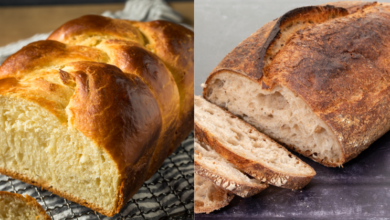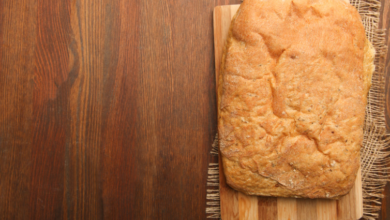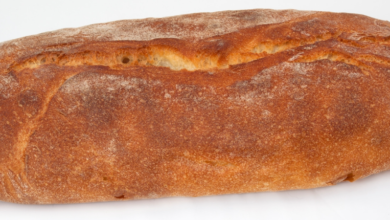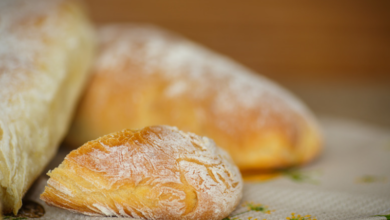Ciabatta Vs. Sourdough: Which Is Better?
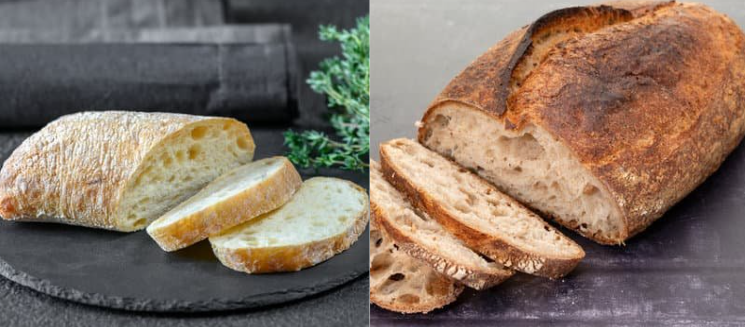
What To Know
- Ciabatta’s flavor is mild and slightly salty, making it a versatile bread that pairs well with a wide range of toppings and fillings.
- Whether you enjoy the airy lightness of ciabatta or the tangy depth of sourdough, there is a place for both these exceptional breads in the world of gastronomy.
- Sourdough bread has a slight edge in terms of nutritional value, as it contains higher levels of dietary fiber and a lower glycemic index.
In the realm of bread, two titans stand tall: ciabatta and sourdough. Both beloved for their distinct flavors and textures, these breads have captured the hearts and palates of bread enthusiasts worldwide. But which bread reigns supreme? Let’s delve into the fascinating world of ciabatta vs sourdough bread to unveil their unique characteristics and determine which one emerges victorious.
Crust and Crumb: A Tale of Two Textures
Ciabatta, hailing from Italy, boasts a thin, crispy crust that shatters upon the first bite. Its crumb is airy and open, with large, irregular holes that give it a characteristic lightness. Sourdough, on the other hand, has a thicker, chewy crust that develops a slightly tangy flavor as it ferments. Its crumb is denser and more evenly distributed, resulting in a more substantial bread.
Flavor Profile: A Symphony of Sour and Savory
Ciabatta’s flavor is mild and slightly salty, making it a versatile bread that pairs well with a wide range of toppings and fillings. Sourdough, however, is known for its distinctive sour flavor, a result of the fermentation process that produces lactic acid. This tangy note adds a unique depth of flavor to everything from sandwiches to crusty loaves.
The Art of Fermentation: A Journey of Time and Craft
Ciabatta is typically made using a commercial yeast, which results in a faster fermentation process. This gives ciabatta its airy texture and mild flavor. Sourdough, on the other hand, relies on a natural sourdough starter that is cultivated over time. This starter, made from flour and water, introduces a complex blend of wild yeasts and bacteria that contribute to sourdough’s distinctive flavor and aroma.
Nutritional Value: A Matter of Health and Well-being
Both ciabatta and sourdough bread offer a good source of carbohydrates, providing energy for the body. However, sourdough bread has a slight edge in terms of nutritional value. It contains higher levels of dietary fiber, which aids in digestion and promotes satiety. Additionally, sourdough bread is known for its low glycemic index, which means it releases sugar into the bloodstream more slowly, helping to regulate blood sugar levels.
Culinary Versatility: A Bread for Every Occasion
Ciabatta’s versatility makes it a perfect choice for sandwiches, bruschetta, and grilled paninis. Its light and airy texture complements a variety of fillings and toppings without overpowering them. Sourdough, with its tangy flavor and chewy texture, shines in crusty loaves, sourdough pizzas, and artisan sandwiches. Its robust flavor stands up to bold ingredients and complements hearty fillings.
The Verdict: A Matter of Personal Preference
The ultimate winner in the battle of ciabatta vs sourdough bread is a matter of personal preference. Both breads offer unique flavors, textures, and culinary applications.
- If you prefer a light and airy bread with a mild flavor, ciabatta is an excellent choice.
- If you appreciate a tangy, chewy bread with a complex flavor, sourdough bread is the clear winner.
The Final Bite: A Harmonious Coexistence
While ciabatta and sourdough bread may appear as rivals, they can harmoniously coexist in the bread basket. Each bread has its own strengths and weaknesses, making them suitable for different occasions and culinary preferences. Whether you enjoy the airy lightness of ciabatta or the tangy depth of sourdough, there is a place for both these exceptional breads in the world of gastronomy.
Frequently Asked Questions
Q: Which bread is healthier, ciabatta or sourdough?
A: Sourdough bread has a slight edge in terms of nutritional value, as it contains higher levels of dietary fiber and a lower glycemic index.
Q: Can I use ciabatta and sourdough bread interchangeably?
A: While both breads can be used in similar applications, they have different flavor profiles and textures. Ciabatta is lighter and milder, while sourdough is tangier and chewier.
Q: How do I store ciabatta and sourdough bread?
A: Store both breads in a cool, dry place, wrapped tightly in plastic wrap or a bread bag. They can also be frozen for up to 3 months.

